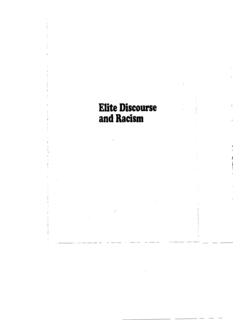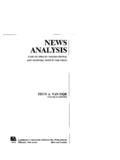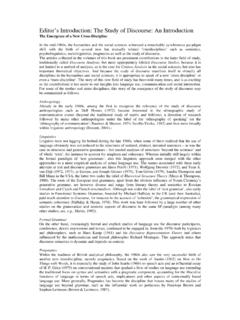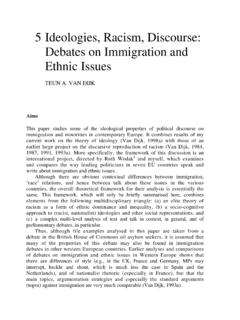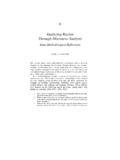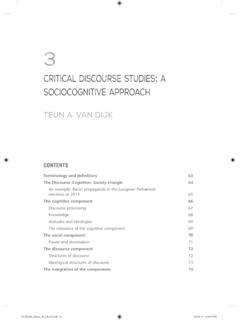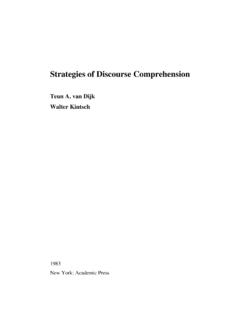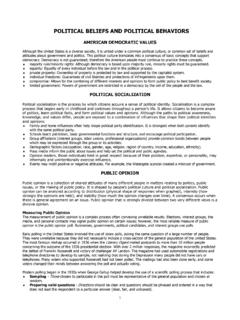Transcription of Ideological Discourse Analysis - Discourse in Society
1 Ideological Discourse Analysis Teun A. van Dijk University of Amsterdam 1. Introduction Ideological Analysis of language and Discourse is a widely practised scholarly and critical endeavour in the humanities and the social sciences. The presupposition of such analyses is that ideologies of speakers or writers may be uncovered by close reading, understanding or systematic Analysis , if language users explicitly or unwittingly express their ideologies through language and communication. Despite these widespread practices and assumptions, however, the theory that relates Discourse and these underlying ideologies is far from explicit. Indeed, in Discourse studies, as well as in cognitive and social psychology or the social sciences, we do not know much about how exactly ideologies are either developed by or through Discourse , on the one hand, or how they control or otherwise influence text and talk, on the other hand.
2 In this paper, therefore, I summarize some theoretical assumptions developed in my current project on Discourse and ideology, and discuss some specific issues that have so far been ignored in the practice of Ideological Discourse Analysis . 2. Social-political Discourse Analysis In order to formulate our research goals in a broader framework, it should first be emphasized that Ideological Discourse Analysis should be seen as one specific type of socio-political Analysis of Discourse . Such an Analysis , among other things, attempts to relate structures of Discourse with structures of Society . That is, social properties or relations of, , class, gender or ethnicity, are thus systematically associated with the structural units, levels, or strategies of talk and text embedded in their social, 136 political and cultural contexts.
3 The same is true for the relations between social organizations, institutions, groups, roles, situations, power, or political decision making, on the one hand, and Discourse structures, on the other hand. (Fairclough, 1989, 1992; Kedar, 1987; Kramarae, Schulz and OBarr, 1984; Kress, 1985; Ng and Bradac, 1993; Wodak, 1989). In such an account, language users are defined as members of communities, groups or organizations, and are supposed to speak, write or understand from a specific social position. Ideological Analysis then examines what ideologies are typically associated with that position, for example, in order to defend or legitimate that position, typically so by Discourse .
4 In relationships of dominance, such Ideological Discourse may thus serve to sustain or challenge social positions. This socio-political approach to Ideological Analysis is classical, but hardly explicit. Rather crucially, it fails to tell us how exactly social positions of language users or of the groups of which they are members affect (or are affected by) text and talk. Men, and not women, may have recourse to specific topics, lexical style or rhetoric, or vice versa, and the same may be said for whites vs. blacks, old vs. young people, or police officers vs. suspects. As is the case in sociolinguistics, such an Analysis hardly goes beyond correlational description: It neither explains nor specifies how such group members may thus express their social positions, that is, what Discourse production processes are involved in expressing such positions.
5 Trivially, since groups and institutions, as such, do not write or speak or understand Discourse , there is no way social structure itself may directly affect text and talk, unless through the agency of communicating individuals as members of groups or social categories. That is, as is the case for many other forms of social and political Analysis , a fully fledged explanation of the relations between Discourse and Society needs to cross the well-known macro-micro and Society -individual divide (Alexander, Giesen, Munch and Smelser, 1987; Knorr-Cetina and Cicourel, 1981). This means that we need a theoretical interface where the social and the discursive can meet and be explicitly related to each other.
6 One candidate for this interface is situated social interaction itself. Depending on ones perspective or sociological theory, either the macro or the micro may be taken as more basic in such an account (Collins, 1981; Fine, 1991). Situations would then represent the unique combination of social members, categories, relations, processes or forces. For instance, a specific encounter between doctor and patient would be instantiating or enacting 137 more abstract structures of medical institutions in general, and relations between doctors and patients in particular (Mishler, 1984; West, 1984). Talk of social members in such a context might instantiate, more or less directly, one type of social relation, , that of dominance, politeness, assistance or solidarity.
7 More specifically, this would probably entail the use of expressions that may be intended or interpreted as signalling such social relations, as may be the case for pronouns as markers of dominance or politeness. 3. The socio-cognitive interface Although this Society -actor interface provides us with insight into one dimension of the macro-micro divide, it is incomplete. What we also need is a socio-cognitive interface. Arguments for the necessity of this interface are the following: (1) The very notions of (social) action and actor themselves have an important cognitive dimension: Knowledge about conditions and consequcnces, plans, intentions and goals of actions, as well as the very action concepts themselves, are properties of thinking or of mental representations, that is, of the mind (Aebli, 1980; Danto, 1973; Whitelcy, 1973; but see Coulter, 1989).
8 (2) The same is true for interaction, action co-ordination and the strategic adaptation of action to the social context, which all require mental representations of other actors (and their representations) as well as of the relevant properties of the situation or context (Furnham and Argyle, 1981 ). (3) Similarly, the social macro-micro link defined in terms of group membership of social actors and of their actions taken as instantiations of social relations, processes or structures also needs a cognitive dimension (Cicourel, 1973). Group members need to identify and represent themselves as being members of groups in order to be able to act as group members. They bring to bear shared, general knowledge about Society and interaction in the competent execution of their actions, as well as in the understanding of the actions of others (Fiske and Taylor, 1991; Farr and Moscovici, 1984).
9 (4) The same is a fortiori true for verbal interaction and Discourse , whose structures and meanings, planning and understanding, also need to be formulated in terms of a cognitive account of the mind, involving 138 specific and shared knowledge and other social beliefs (van Dijk and Kintsch, 1983). Spelling out these arguments would require a lengthy theoretical and philosophical Analysis , which cannot be given here. For our purposes, then, we shall simply assume that these arguments are valid, and that the relations between Society and interaction, and hence between Society and Discourse , are necessarily indirect, and mediated by shared mental representations of social actors as group members.
10 Indeed, the very knowledge of language and Discourse is a prominent example of the shared social cognitions of groups and their members. 4. Ideologies It will be further assumed that the same is true for ideologies. Ignoring a vast discussion of ideologies in the social sciences (CCCS, 1978; Eagleton, 1991; Larrain, 1979; Thompson, 1984), we shall here simply define ideologies as systems that are at the basis of the socio-political cognitions of groups (Lau and Sears, 1986; Rosenberg, 1988). Thus, ideologies organize social group attitudes consisting of schematically organized general opinions about relevant social issues, such as abortion, nuclear energy or affirmative action (Eagly and Chaiken, 1993).

